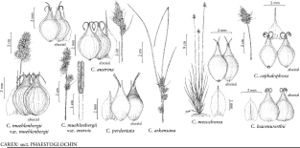Carex austrina
Bull. Torrey Bot. Club 34: 151. 1907.
Plants without conspicuous rhizomes. Culms 20–90 cm, 1.5–3 mm wide basally, 0.9–1.1 mm wide distally. Leaves: sheaths tight, green, fronts hyaline, yellowish and thickened at mouth; ligules to 3 mm, as long as wide; widest leaf-blades 2.5–4.5 mm wide, sometimes papillose adaxially. Inflorescences with (3–) 5–10 spikes, 1.5–3.5 cm × 8–15 mm; proximal internodes equaling or shorter than proximal spikes; proximal bracts 1–5 cm; spikes with 8–20 ascending or spreading perigynia. Pistillate scales hyaline or brown with green, 3-veined center, ovate, (2.4–) 3–4.3 × (1–) 1.6–3 mm, body slightly shorter to longer than perigynium and as wide, apex awned to 1.5–3.5 (–4) mm. Anthers 2.2–2.5 mm. Perigynia pale green, pale-yellow, or pale-brown, 9–15-veined abaxially, 3.5–5 × 2.2–3 mm, margins serrulate distally; beak 0.8–1.2 mm, apical teeth 0.4–0.6 mm. Achenes suborbiculate, 1.9–2.5 × 1.5–2 mm.
Phenology: Fruiting late spring–early summer.
Habitat: Dry prairies, forests, roadside ditches, often in calcareous soils
Elevation: 100–500 m
Distribution

Ala., Ark., Iowa, Kans., Ky., La., Miss., Mo., Nebr., Okla., Tenn., Tex.
Discussion
Selected References
None.
Lower Taxa
"shortened" is not a number.
